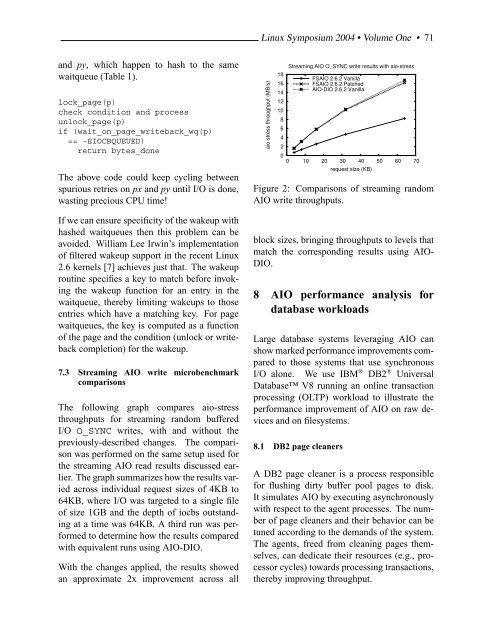You also want an ePaper? Increase the reach of your titles
YUMPU automatically turns print PDFs into web optimized ePapers that Google loves.
<strong>Linux</strong> Symposium 2004 • Volume <strong>One</strong> • 71<br />
and py, which happen to hash to the same<br />
waitqueue (Table 1).<br />
lock_page(p)<br />
check condition and process<br />
unlock_page(p)<br />
if (wait_on_page_writeback_wq(p)<br />
== -EIOCBQUEUED)<br />
return bytes_done<br />
<strong>The</strong> above code could keep cycling between<br />
spurious retries on px and py until I/O is done,<br />
wasting precious CPU time!<br />
If we can ensure specificity of the wakeup with<br />
hashed waitqueues then this problem can be<br />
avoided. William Lee Irwin’s implementation<br />
of filtered wakeup support in the recent <strong>Linux</strong><br />
2.6 kernels [7] achieves just that. <strong>The</strong> wakeup<br />
routine specifies a key to match before invoking<br />
the wakeup function for an entry in the<br />
waitqueue, thereby limiting wakeups to those<br />
entries which have a matching key. For page<br />
waitqueues, the key is computed as a function<br />
of the page and the condition (unlock or writeback<br />
completion) for the wakeup.<br />
7.3 Streaming AIO write microbenchmark<br />
comparisons<br />
<strong>The</strong> following graph compares aio-stress<br />
throughputs for streaming random buffered<br />
I/O O_SYNC writes, with and without the<br />
previously-described changes. <strong>The</strong> comparison<br />
was performed on the same setup used for<br />
the streaming AIO read results discussed earlier.<br />
<strong>The</strong> graph summarizes how the results varied<br />
across individual request sizes of 4KB to<br />
64KB, where I/O was targeted to a single file<br />
of size 1GB and the depth of iocbs outstanding<br />
at a time was 64KB. A third run was performed<br />
to determine how the results compared<br />
with equivalent runs using AIO-DIO.<br />
With the changes applied, the results showed<br />
an approximate 2x improvement across all<br />
aio-stress throughput (MB/s)<br />
18<br />
16<br />
14<br />
12<br />
10<br />
8<br />
6<br />
4<br />
2<br />
Streaming AIO O_SYNC write results with aio-stress<br />
FSAIO 2.6.2 Vanilla<br />
FSAIO 2.6.2 Patched<br />
AIO-DIO 2.6.2 Vanilla<br />
0<br />
0 10 20 30 40 50 60 70<br />
request size (KB)<br />
Figure 2: Comparisons of streaming random<br />
AIO write throughputs.<br />
block sizes, bringing throughputs to levels that<br />
match the corresponding results using AIO-<br />
DIO.<br />
8 AIO performance analysis for<br />
database workloads<br />
Large database systems leveraging AIO can<br />
show marked performance improvements compared<br />
to those systems that use synchronous<br />
I/O alone. We use IBM ® DB2 ® Universal<br />
Database V8 running an online transaction<br />
processing (OLTP) workload to illustrate the<br />
performance improvement of AIO on raw devices<br />
and on filesystems.<br />
8.1 DB2 page cleaners<br />
A DB2 page cleaner is a process responsible<br />
for flushing dirty buffer pool pages to disk.<br />
It simulates AIO by executing asynchronously<br />
with respect to the agent processes. <strong>The</strong> number<br />
of page cleaners and their behavior can be<br />
tuned according to the demands of the system.<br />
<strong>The</strong> agents, freed from cleaning pages themselves,<br />
can dedicate their resources (e.g., processor<br />
cycles) towards processing transactions,<br />
thereby improving throughput.

















